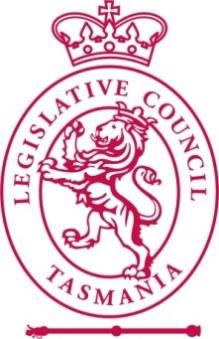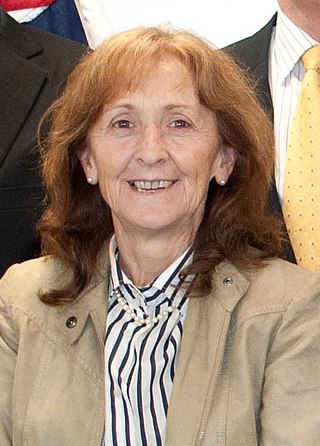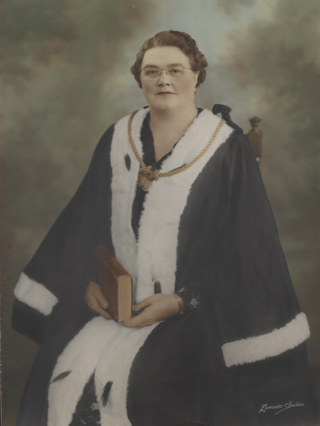Timeline

There have been 22 women in the Tasmanian Legislative Council since its establishment in 1825. Women have had the right to vote since 1903 and the right to stand as candidates since 1921.
The first successful female candidate for the Legislative Council was Margaret McIntyre, who was elected as the member for Cornwall in 1948. Like most MLCs, McIntyre was an independent. She died later in 1948 in an air accident, and the next woman elected to the Council was Labor's Lucy Grounds in 1951. Another Labor woman, Phyllis Benjamin, joined Grounds in 1952; Grounds retired in 1958 and Benjamin in 1976, in which year Kath Venn was elected to the Council. After Venn's departure in 1982 there were no women in the Council until 1992, when Jean Moore was elected. She departed in 1994, and since the election of Silvia Smith and Sue Smith to the Council in 1997 women have been represented continuously. In 2009, Vanessa Goodwin became the first Liberal woman elected to the Council.
Names in bold indicate women who have been appointed as Ministers and Parliamentary Secretaries during their time in Parliament. Names in italics indicate entry into Parliament through a by-election or by appointment.
| # | Name | Party | Electoral Division | Period of service |
|---|---|---|---|---|
| 1 | Margaret McIntyre | Independent | Cornwall | 8 May 1948 – 2 September 1948 (died) |
| 2 | Lucy Grounds | Labor | Launceston | 29 September 1951 – 10 May 1958 (defeated) |
| 3 | Phyllis Benjamin | Labor | Hobart | 10 May 1952 – 22 May 1976 (retired) |
| 4 | Kath Venn | Labor | Hobart | 22 May 1976 – 27 May 1982 (defeated) |
| 5 | Jean Moore | Independent | Hobart | 11 April 1992 – 28 May 1994 (defeated) |
| 6 | Silvia Smith | Independent | Westmorland Windermere | 31 May 1997 – 3 May 2003 (defeated) |
| Sue Smith | Independent | Leven Montgomery | 31 May 1997 – 4 May 2013 (retired) | |
| 8 | Cathy Edwards | Independent | Pembroke | 28 August 1999 – 5 May 2001 (defeated) |
| Lin Thorp | Labor | Rumney | 28 August 1999 – 7 May 2011 (defeated) | |
| 10 | Allison Ritchie | Labor | Pembroke | 5 May 2001 – 20 June 2009 (resigned) |
| 11 | Norma Jamieson | Independent | Mersey | 3 May 2003 – 2 May 2009 (retired) |
| 12 | Tania Rattray | Independent | Apsley McIntyre | 1 May 2004 – |
| 13 | Ruth Forrest | Independent | Murchison | 7 May 2005 – |
| 14 | Vanessa Goodwin | Liberal | Pembroke | 12 August 2009 – 2 October 2017 (resigned) |
| 15 | Adriana Taylor | Independent | Elwick | 1 May 2010 – 7 May 2016 (defeated) |
| 16 | Rosemary Armitage | Independent | Launceston | 7 May 2011 – |
| 17 | Leonie Hiscutt | Liberal | Montgomery | 4 May 2013 – |
| 18 | Sarah Lovell | Labor | Rumney | 6 May 2017 – |
| 19 | Jo Siejka | Labor | Pembroke | 4 November 2017 – |
| 20 | Jane Howlett | Liberal | Prosser | 5 May 2018 – |
| 21 | Meg Webb | Independent | Nelson | 4 May 2019 – |
| 22 | Jo Palmer | Liberal | Rosevears | 1 August 2020 – |


The Tasmanian Legislative Council is the upper house of the Parliament of Tasmania in Australia. It is one of the two chambers of the Parliament, the other being the House of Assembly. Both houses sit in Parliament House in the state capital, Hobart. Members of the Legislative Council are often referred to as MLCs.

Margaret Edgeworth David McIntyre, was the first woman elected to the Parliament of Tasmania, representing the seat of Cornwall in the Legislative Council.

Janelle Anne Saffin is an Australian Labor Party politician. She has been the Member for Lismore in the New South Wales Legislative Assembly since 23 March 2019. She was the Member for Page in the Australian House of Representatives from 2007 to 2013, and a Member of the New South Wales Legislative Council from 1995 to 2003.
There have been 121 women in the Australian Senate since the establishment of the Parliament of Australia. Women have had the right to stand for federal parliament since 1902, and there were three female candidates for the Senate at the 1903 federal election. However, it was not until Dorothy Tangney's victory at the 1943 federal election that a woman was elected. Since then, all states and territories have had multiple female senators – in chronological order: Western Australia (1943), Queensland (1947), Victoria (1950), South Australia (1955), Tasmania (1975), the Australian Capital Territory (1975), New South Wales (1987), and the Northern Territory (1998).
Government in Australia is elected by universal suffrage and Australian women participate in all levels of the government of the nation. In 1902, the newly formed Commonwealth of Australia became the first nation on earth to enact equal suffrage, enabling women to both vote and stand for election alongside men Women have been represented in Australian state parliaments since 1921, and in the Federal Parliament since 1943. The first female leader of an Australian State or Territory was elected in 1989, and the first female Prime Minister took office in 2010. In 2019 for the first time, a majority of members of the Australian Senate were women. At the time of its foundation in 1901, and again since 1952, Australia has had a female monarch as ceremonial Head of State, while the first female Governor of an Australian State was appointed in 1991, and the first female Governor-General of Australia took office in 2008.
Gender representation has been a significant issue in Canadian politics.

Louise Clare Pratt is an Australian politician who has been a Senator for Western Australia since 2016, and previously from 2008 to 2014. She is a member of the Labor Party, and served as a member of the Western Australian Legislative Council from 2001 to 2007. She was the youngest woman ever elected to the Legislative Council at the time of her election, the second open lesbian to be elected to an Australian parliament, and was the first to have a transgender man as a partner.
There have been 81 women in the New South Wales Legislative Assembly since its establishment in 1856. Women have had the right to vote in the assembly since 1902 and the right to stand as a candidate since 1918.
This is a list of members of the Tasmanian Legislative Council between 1945 and 1951. Terms of the Legislative Council did not coincide with Legislative Assembly elections, and members served six year terms, with a number of members facing election each year.

Elizabeth Lilian Maud Fowler MBE, JP was an Australian politician. She was Australia's first female mayor, serving as mayor of Newtown, New South Wales, from 1937 to 1939. She later represented the seat of Newtown in the New South Wales Legislative Assembly from 1944 to 1950. She had a long involvement with the Lang Labor faction of the Australian Labor Party (ALP), which had evolved into a separate party by the time of her election to Parliament.
There have been 60 women in the New South Wales Legislative Council since its establishment in 1856. Women have had the right to stand as a candidate since 1918; the Council introduced direct election in 1978.
There have been 98 women in the Victorian Legislative Assembly since its establishment in 1856. Women have had the right to vote in Victoria, Australia since 1908 and the right to stand as a candidate for the Victorian Legislative Assembly since 1923.
There have been 60 women in the Victorian Legislative Council since its establishment in 1856. Women have had the right to vote in Victoria, Australia since 1908 and the right to stand as a candidate for the Victorian Legislative Council since 1923. As of September 2020, there were 17 women in the 40 member Legislative Council.
There have been 97 women in the Legislative Assembly of Queensland since its establishment in 1860. Women have had the right to vote in the Assembly since 1905 and the right to stand as candidates since 1915.
There have been 66 women in the Western Australian Legislative Assembly since its establishment in 1890. Women have had the right to vote since 1899 and the right to stand as candidates since 1920.
There have been 54 women in the Western Australian Legislative Council since its creation in 1832. Women have had the right to vote since 1899 and the right to stand as candidates since 1920.
There have been 38 women in the Tasmanian House of Assembly since its establishment in 1856. Women have had the right to vote since 1903 and the right to stand as candidates since 1921.
There have been 51 women in the South Australian House of Assembly since its establishment in 1857. Women have had the right to vote and the right to stand as candidates since 1894.
There have been 24 women in the South Australian Legislative Council since its establishment in 1840. Women have had the right to vote and stand as candidates since 1894.

The 2014 South Australian state election elected members to the 53rd Parliament of South Australia on 15 March 2014, to fill all 47 seats in the House of Assembly and 11 of 22 seats in the Legislative Council. The 12-year-incumbent Australian Labor Party (SA) government, led by Premier Jay Weatherill, won its fourth consecutive four-year term in government, a record 16 years of Labor government, defeating the opposition Liberal Party of Australia (SA), led by Opposition Leader Steven Marshall.